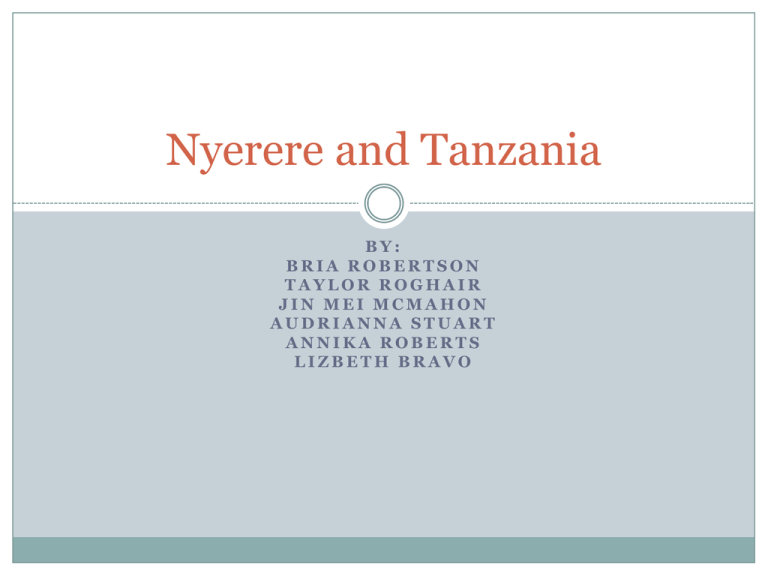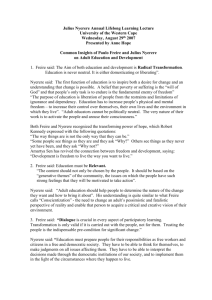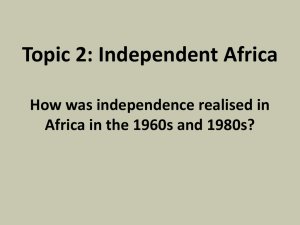political-structure(1)
advertisement

Nyerere and Tanzania BY: BRIA ROBERTSON TAYLOR ROGHAIR JIN MEI MCMAHON AUDRIANNA STUART ANNIKA ROBERTS LIZBETH BRAVO Move to Independence: The Elections Richard Turnbull Like a sir. -1958: Elections were held -TANU had an overwhelming victory, winning all 15 seats in LEGCO -They showed the British that Tanganyikans wanted Africans in power -Sir Richard Turnbull took over for Twining and supported Nyerere and TANU in their push to independence. Move to Independence: Post-Election -1960: Further elections were held, TANU won easily. -1961: Tanganyika granted full independence, with Nyerere as Prime Minister. -TANU and African National Congress (ANC) were two Nationalist parties. TANU had more influence. -The transition that took place from dependence to independence was perhaps one of the most peaceful, and happened entirely through honest politics. “Uhuru na Kazi," or "Freedom and Work" Prime Minister Julius Nyerere Sources: Pearson Text: 190-191 English to Swahili Translator- http://imtranslator.net/translation/english/toswahili/translation/ Foreign Policy (1961-85) Objectives: Ensure national security through diplomatic means. Support liberation movements in Africa and work towards African unity. Goal = a more unified eastern Africa Treaty for East African Cooperation (1967). Fell apart because of disagreements of Nyerere and Kenya. Targeted racist regimes (Southern Rhodesia, Mozambique). Formed alliance of Front Line States to support liberation movements. Supported liberation groups from socialist nations, made the west nervous Promote the policy of non alignment through the Organization of African Unity (OAU). Helped found the OAU with the goals of: Unifying Africa, eradicating colonialism, improving the quality of life for all Africans, and defending independence of African states. Focused on these goals by adopting the policy of non-alignment (see cold war positioning). Source: Pearson text p. 197-198 POLITICAL STRUCTURE OF TANGANYIKA WESTMINSTER CONSTITUTIONAL MODEL The model Tanganyika first based their government on. This model focuses around a democratic, parliamentary system (like the UK) where executive power is rooted in Parliament/Cabinet. Used by most Commonwealth Nations post-independence. (British Commonwealth = group of nations aligned with the Crown, includes former colonies that are now sovereign states.) Nyerere served as Prime Minister until January 1962, when he resigned. RESTRUCTURING OF GOVERNMENT Nyerere decided the Westminster model was not the best for Tanganyika. He believed in African socialism (“Ujamaa,” focus on the extended family), not Western capitalism. True democracy could occur through a single-party state where representatives are elected fairly by the people. December 1962: A new constitution was introduced, making Tanganyika a republic. NYERERE IN THE NEW REPUBLIC The role of Prime Minister was replaced by a President, and… … in December 1962, Nyerere was elected the new President, winning 97% of the vote. He continued advocating African socialism and criticizing capitalism. SOURCES Pearson History Text, pages 193-194 Riverside Community College (Political Science) Wikipedia The Single Party State - T A N G A N Y I K A T U R N E D I N T O A O N E P A R T Y S T A T E O N 1 4 TH OF JANUARY, 1963 BY NYERERE. -CENTRIFUGAL TENDENCIES TEND TO BE DANGEROUS IN THESE AREAS. -Tanzania was divided into 26 regions -21 on mainland -3 on Zanzibar -2 on Pemba -Minimum voting age was 21 -President had the power of Governor General, first Prime Minister, Head of State as well as commander in chief. Sources: Pearson Text pg. 196 & Wikipedia 1965 Constitution Interim Constitution of 1964 Merged Zanzibar and Tanzania into “ United Republic of Tanzania.” Based off of constitution of ’62 with changes added in agreements with TANU (Tanzania’s Single Party & Afro-Shirazi Party(ASP) of Zanzibar). Republican constitution of ‘62 gave president lots of power. • Changes of 1965: • Constitution identified 2 single parties TANU for the Union & ASP for Zanzibar. • Used to further strengthen single-party. Sources: Wikipedia Cold War Positioning Tanzania has traditionally maintained a non-aligned during the Cold War. Tanzania began to explore the possibility of moving closer to other socialist states while still keeping their policy of nonalignment. Tanzania becomes more economically dependent on PRC (Peoples Republic of China). 1967= Tanzania globally recognized as non-aligned. Pearson text: pages 198-199 Cold War Positioning Cont. 1971= Relations between Uganda and Tanzania begin to deteriorate with the overthrow of Milton Obote by Idi Amin. 1978= Ugandan forces attack province of Kagera; war between Uganda and Tanzania begins. Nyerere appeals to OAC; OAC does not take any action. Nyerere orders Ugandan army to attack Uganda. 1979= Occupation of Kampala leads to the defeat of Uganda and the end of Idi Amin’s government. Nyerere appoints himself leader of Uganda. The cost of the war had an impact on Tanzania when they were trying to implement Nyerere’s socialist reforms.


![NyerereandTanzania[1]](http://s2.studylib.net/store/data/010105845_1-19c0ad30f2fc2d1c2e73f2a1fcbde127-300x300.png)








